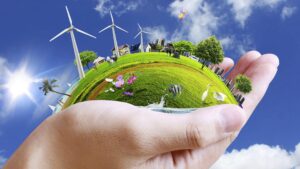Physical Address
23,24,25 & 26, 2nd Floor, Software Technology Park India, Opp: Garware Stadium,MIDC, Chikalthana, Aurangabad, Maharashtra – 431001 India
Physical Address
23,24,25 & 26, 2nd Floor, Software Technology Park India, Opp: Garware Stadium,MIDC, Chikalthana, Aurangabad, Maharashtra – 431001 India

The 2024 Sri Lankan Presidential Election has placed the nation’s environmental policies and climate resilience at the forefront, with leading candidates presenting contrasting visions for addressing climate change. While Ranil Wickremesinghe, Sajith Premadasa, and Anura Kumara Dissanayake each focus on sustainable development, their approaches to the climate crisis diverge in both scope and strategy.
Ranil Wickremesinghe: A Green Economy for the Future
President Ranil Wickremesinghe’s manifesto outlines a proactive stance on climate change, emphasizing disaster-resilient cities, green energy, and biodiversity conservation. His vision is clear: to turn the challenges of global warming into economic opportunities for Sri Lanka. Wickremesinghe proposes the establishment of a Climate Change Secretariat and Climate Change Fund, which will help mitigate the country’s climate risks. Moreover, his government has positioned Sri Lanka as a key player in international climate efforts, including participation in the Global Financing Pact and the Global Blended Financial Alliance.
Under his leadership, Sri Lanka aims to reach 70% renewable energy by 2030, further solidifying its commitment to becoming a Green Energy Hub in South Asia. Wickremesinghe’s approach leans on leveraging international collaborations, such as the Climate Justice Forum and International Climate Change University, which positions Sri Lanka at the forefront of the global climate agenda. Read the manifestos in English here
Sajith Premadasa: Commitment to Sustainable Development Goals
Opposition leader Sajith Premadasa, representing the Samagi Jana Sandhanaya (SJS), aligns his climate policies closely with the United Nations Sustainable Development Goals (SDGs). His manifesto places heavy emphasis on updating the National Environmental Act and adopting eco-friendly energy solutions. Premadasa also advocates for renewable energy sources like solar, wind, wave energy, and green hydrogen, while promoting science-based solutions to mitigate human-wildlife conflicts, a significant issue in rural areas.
Premadasa’s approach reflects a balance between development and environmental protection, prioritizing the Paris Agreement’s global warming targets. His pledge to reduce greenhouse gas emissions and reliance on fossil fuels is complemented by his support for community-driven conservation efforts, especially regarding Sri Lanka’s wildlife. Read the manifestos in English here
Anura Kumara Dissanayake: A Radical Shift for Environmental Justice
Anura Kumara Dissanayake, leader of the Jathika Jana Balawegaya (NPP), presents the most transformative environmental agenda. His vision for an evergreen Sri Lanka is built on the principle of environmental justice and fairness, advocating for sustainable resource use and ecosystem-based approaches. Unlike his counterparts, Dissanayake emphasizes the polluter pays principle, aiming to hold corporations accountable for environmental degradation.
His manifesto prioritizes proper land-use planning, comprehensive water resource management, and the cessation of pollutants entering marine and coastal zones. The NPP proposes stringent legal reforms and better institutional coordination to ensure that environmental policies are enforced, addressing gaps in the existing system. Watch his Environmental policy in Sinhala here
Dissanayake’s plan is deeply rooted in community participation, promoting agroforestry, early warning systems for natural disasters, and public consultation in feasibility studies for development projects. He also advocates for strict control over human-wildlife interactions and better solid waste management based on 3R principles. Read the manifestos in English here
Key Comparisons and Contrasts
Conclusion
The 2024 Presidential Election presents voters with three distinct pathways to address climate change. Wickremesinghe’s vision is future-forward, focusing on turning global climate challenges into economic opportunities through international collaboration and high-tech solutions. Premadasa balances sustainable development with practical, locally driven initiatives, while Dissanayake offers a radical rethinking of environmental governance, prioritizing justice, sustainability, and strict accountability. Each candidate offers a unique perspective on how Sri Lanka can navigate its environmental challenges, leaving voters with a pivotal decision on the country’s climate future.